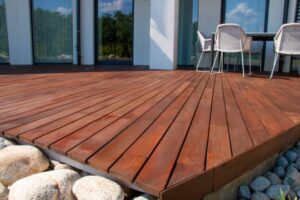At its best, a deck can be an outdoor room that provides a cozy space for solitary relaxation or bonding with family and friends. At its worst, it can be a showcase of homeowners’ tastes, desires, and egos laid out in vast expanses of wood (or products that look like wood) and stone.
Pressure-treated lumber
Pressure-treated lumber is the logical choice for the structural components for SuperbPergolasnDecks decking Adelaide, such as posts and joists. It resists fungal rot and insect damage much better than untreated cedar or redwood and is substantially less expensive. It’s available in standard dimensional lumber sizes, such as two-by-fours and two-by-sixes, and square cross-sections, such as four-by-sixes or six-by-sixes for support posts. Usually, Southern yellow pine (SYP) or Douglas fir predominates in treated deck framing materials. This species is stiff and strong and has a high percentage of sapwood readily absorbing preservative chemicals.
 Ground-contact PT wood (also known as “ground-treated” or “ground-grade”) has additional preservative chemicals to increase its resistance to fungi and insects in applications where it is buried below grade, such as in posts or foundations. It’s also used for joists and beams that will be exposed to the elements.
Ground-contact PT wood (also known as “ground-treated” or “ground-grade”) has additional preservative chemicals to increase its resistance to fungi and insects in applications where it is buried below grade, such as in posts or foundations. It’s also used for joists and beams that will be exposed to the elements.
Wear a dust mask when working with any treated lumber. The sawdust it creates is an irritant, and you should also use protective gloves and goggles when cutting or handling it. If possible, stain your treated deck with a water-repellent finish, paint or a solid-colour stain rather than using oil-based stains, which may contain toxins that leach into the ground and the water supply. Always use labelled fasteners with treated wood, such as stainless steel or hot-dipped galvanised fasteners.
Wood
Wood is the original choice for SuperbPergolasnDecks decking Adelaide, and it’s still popular. It’s natural, strong and feels good under bare feet, but it needs annual cleaning to keep it from rotting, splintering or warping. It also requires a stain or sealant to prevent the sun’s UV rays from fading the colour.
Softwoods, such as pine and fir, can be treated with preservative chemicals to increase their resistance to decay and insects, but the process creates toxic byproducts. Hardwoods, such as cedar and ipe, have a lower environmental impact but are more expensive.
Kiln-dried, natural hardwoods are stronger than pressure-treated lumber and can be cut, drilled, and nailed the same as other types of wood. However, they expand and contract more than other woods, so the boards must be carefully spaced to avoid buckling. Because they also splinter easily, it’s essential to use stainless steel fasteners.
Composites
A new generation of deck materials offers homeowners functional and beautiful options. Composites are a mix of natural or manufactured material that is stronger, more durable and easier to maintain than wood. They are also lighter than traditional materials, making them easier to handle and assemble. It is a major benefit when building decks since homeowners often spend a lot of time on them.
Composites are made of different materials, such as wood fibre and recycled plastic. It makes them ideal for homeowners who are conscious of environmental concerns but also want a stylish look for their homes. Composites are available in various colours and textures and can be shaped to match almost any home style.
Unlike natural wood, composites do not splinter or require painting or staining. They also do not rot or attract mould and mildew, which can cause an unpleasant odour in your yard. They are also more resistant to water damage, making them a good choice for areas that will remain wet for long periods.
Installation
Decks are exposed to the elements, requiring special care to keep them functional, attractive and safe. The material you use, how it is installed, and regular maintenance affect how long your deck will last. Working with a contractor following building and height safety codes is also essential.
Wood: Decks constructed with solid boards must be pretreated with a preservative before installation. Apply the preservative according to the manufacturer’s surface preparation and application instructions. A quality wood preservative will help the deck resist moisture, insects and rot damage for a more effective SuperbPergolasnDecks decking Adelaide project.
Composite: Some types of composite lumber require less maintenance than natural wood, but the decks still need to be cleaned and protected. Using a pressure washer or other power washing equipment is recommended. Regular staining with a water-based wood preservative is also recommended.
Metal fasteners such as joist hangers can be used to prevent sagging and warping. These fasteners connect a joist to the ledger or rim joist, preventing the wood from rotting between the joists.
